OPEL KARL 2015 Owners Manual
Manufacturer: OPEL, Model Year: 2015, Model line: KARL, Model: OPEL KARL 2015Pages: 217, PDF Size: 4.16 MB
Page 131 of 217
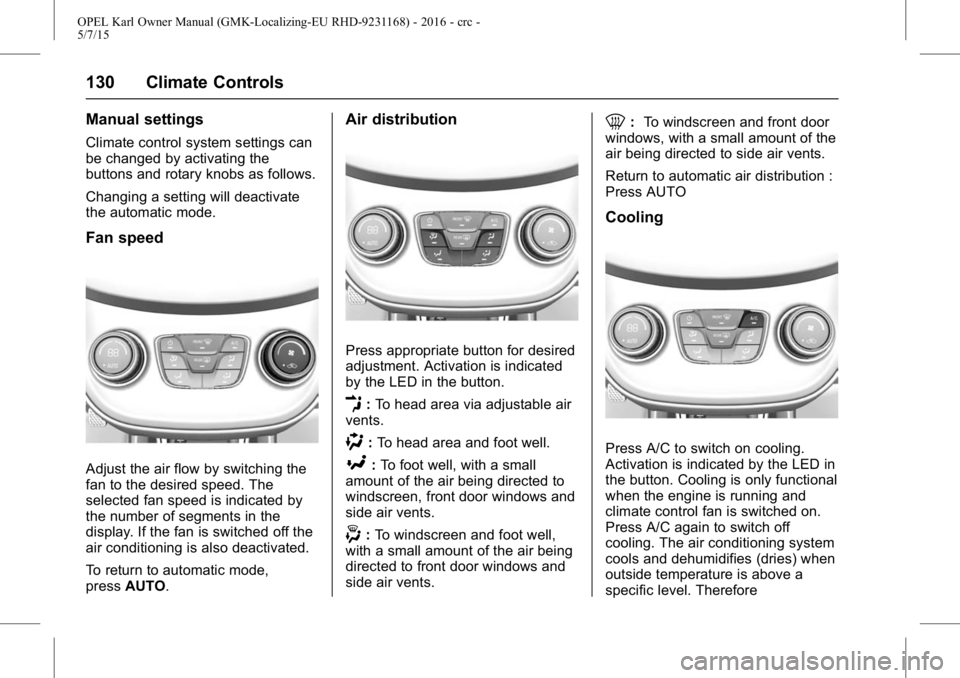
OPEL Karl Owner Manual (GMK-Localizing-EU RHD-9231168) - 2016 - crc -
5/7/15
130 Climate Controls
Manual settings
Climate control system settings can
be changed by activating the
buttons and rotary knobs as follows.
Changing a setting will deactivate
the automatic mode.
Fan speed
Adjust the air flow by switching the
fan to the desired speed. The
selected fan speed is indicated by
the number of segments in the
display. If the fan is switched off the
air conditioning is also deactivated.
To return to automatic mode,
pressAUTO.
Air distribution
Press appropriate button for desired
adjustment. Activation is indicated
by the LED in the button.
E:To head area via adjustable air
vents.
): To head area and foot well.
[:To foot well, with a small
amount of the air being directed to
windscreen, front door windows and
side air vents.
-: To windscreen and foot well,
with a small amount of the air being
directed to front door windows and
side air vents.
0: To windscreen and front door
windows, with a small amount of the
air being directed to side air vents.
Return to automatic air distribution :
Press AUTO
Cooling
Press A/C to switch on cooling.
Activation is indicated by the LED in
the button. Cooling is only functional
when the engine is running and
climate control fan is switched on.
Press A/C again to switch off
cooling. The air conditioning system
cools and dehumidifies (dries) when
outside temperature is above a
specific level. Therefore
Page 132 of 217
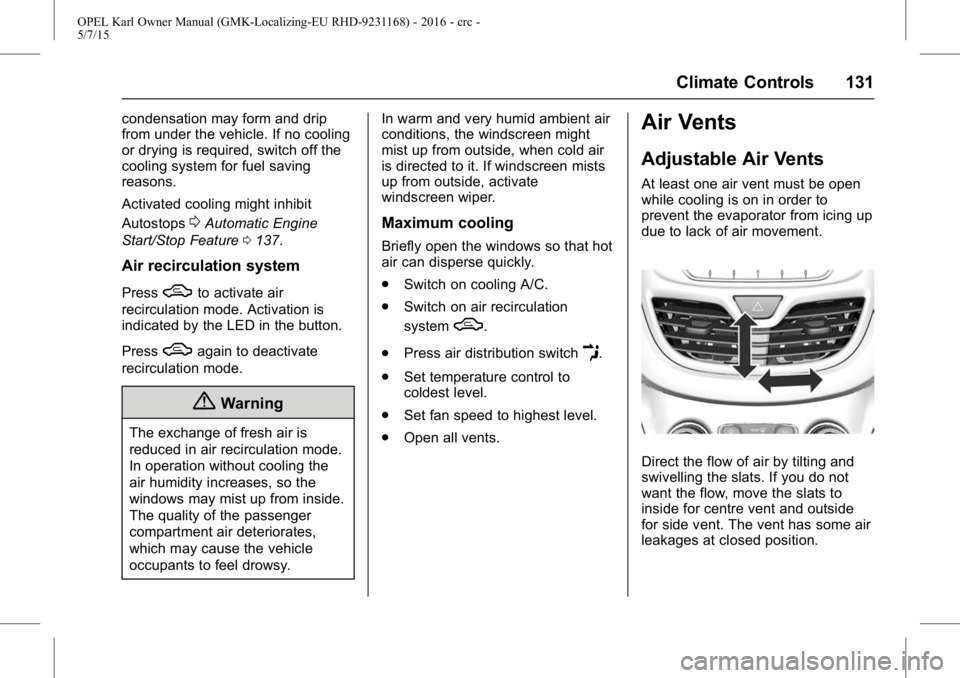
OPEL Karl Owner Manual (GMK-Localizing-EU RHD-9231168) - 2016 - crc -
5/7/15
Climate Controls 131
condensation may form and drip
from under the vehicle. If no cooling
or drying is required, switch off the
cooling system for fuel saving
reasons.
Activated cooling might inhibit
Autostops
0Automatic Engine
Start/Stop Feature 0137.
Air recirculation system
PressWto activate air
recirculation mode. Activation is
indicated by the LED in the button.
Press
Wagain to deactivate
recirculation mode.
{Warning
The exchange of fresh air is
reduced in air recirculation mode.
In operation without cooling the
air humidity increases, so the
windows may mist up from inside.
The quality of the passenger
compartment air deteriorates,
which may cause the vehicle
occupants to feel drowsy. In warm and very humid ambient air
conditions, the windscreen might
mist up from outside, when cold air
is directed to it. If windscreen mists
up from outside, activate
windscreen wiper.
Maximum cooling
Briefly open the windows so that hot
air can disperse quickly.
.
Switch on cooling A/C.
. Switch on air recirculation
system
W.
. Press air distribution switch
E.
. Set temperature control to
coldest level.
. Set fan speed to highest level.
. Open all vents.
Air Vents
Adjustable Air Vents
At least one air vent must be open
while cooling is on in order to
prevent the evaporator from icing up
due to lack of air movement.
Direct the flow of air by tilting and
swivelling the slats. If you do not
want the flow, move the slats to
inside for centre vent and outside
for side vent. The vent has some air
leakages at closed position.
Page 133 of 217

OPEL Karl Owner Manual (GMK-Localizing-EU RHD-9231168) - 2016 - crc -
5/7/15
132 Climate Controls
{Warning
Do not attach any objects to the
slats of the air vents. Risk of
damage and injury in case of an
accident.
Fixed Air Vents
Additional air vents are located
beneath the windscreen and door
windows and in the foot wells.
These are fixed and cannot be
adjusted.
Maintenance
Air Intake
The air intake in front of the
windscreen in the engine
compartment must be kept clear to
allow air intake. Remove any
leaves, dirt or snow.
Passenger Compartment
Air Filter
Cabin air filtration
The particle filter cleans the cabin
air from solid particulates such as
pollen, dust, soot from the air. The
filter should be replaced as part of
routine scheduled maintenance.
Caution
More frequent maintenance of the
air filter is required if the driving
circumstances are dusty roads,
air pollution areas, and frequent
unpaved roads. It makes the filter
efficiency to be decreased and
the bronchus to be bad effected.
Air Conditioning Regular
Operation
In order to ensure continuously
efficient performance, cooling must
be operated for a few minutes once
a month, irrespective of the weather
Page 134 of 217
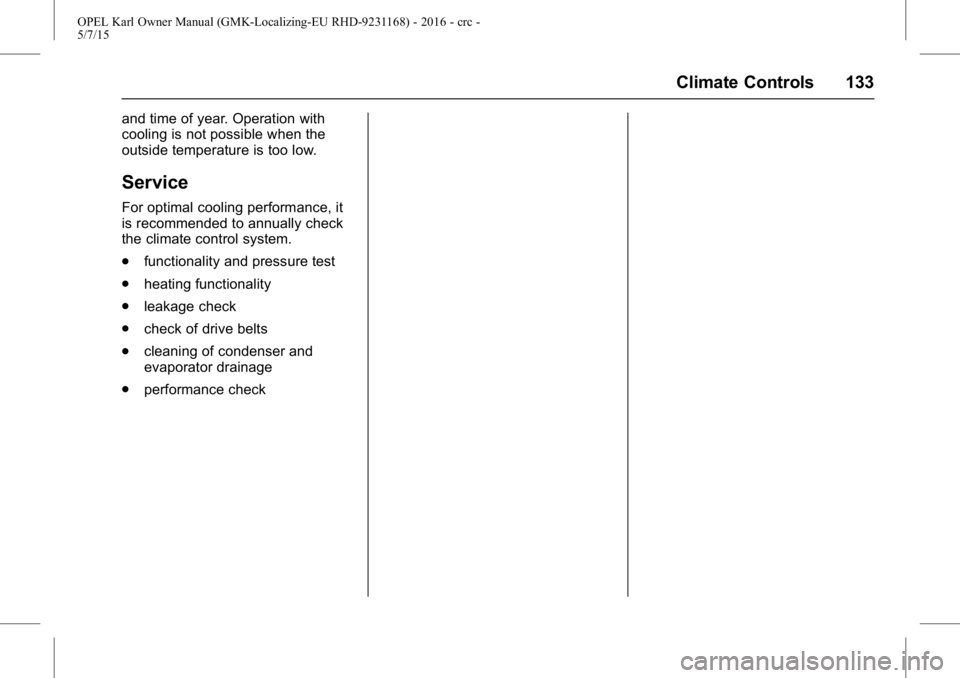
OPEL Karl Owner Manual (GMK-Localizing-EU RHD-9231168) - 2016 - crc -
5/7/15
Climate Controls 133
and time of year. Operation with
cooling is not possible when the
outside temperature is too low.
Service
For optimal cooling performance, it
is recommended to annually check
the climate control system.
.functionality and pressure test
. heating functionality
. leakage check
. check of drive belts
. cleaning of condenser and
evaporator drainage
. performance check
Page 135 of 217
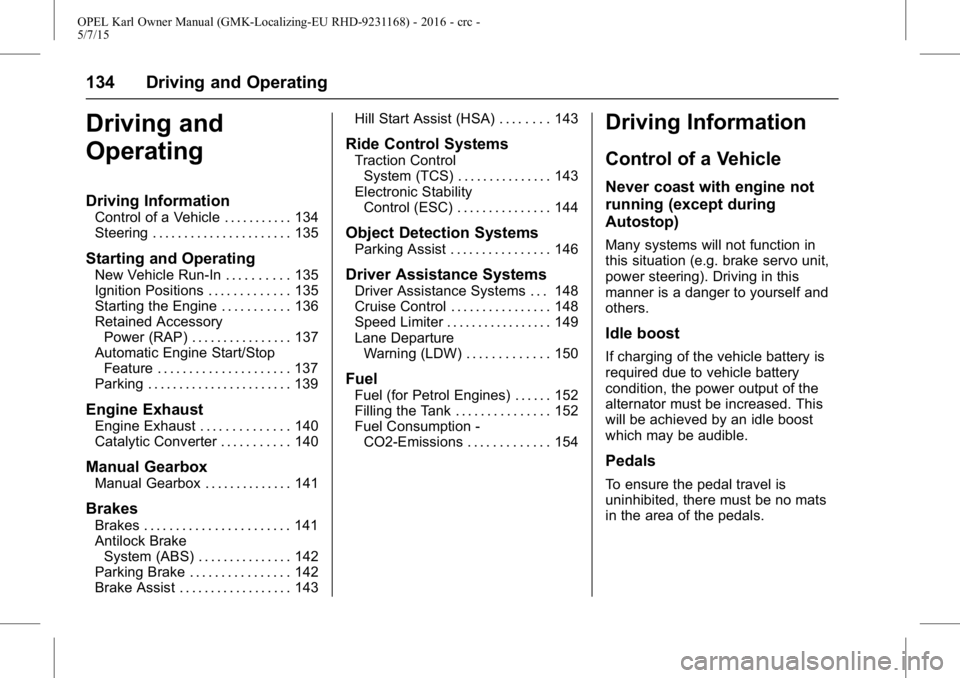
OPEL Karl Owner Manual (GMK-Localizing-EU RHD-9231168) - 2016 - crc -
5/7/15
134 Driving and Operating
Driving and
Operating
Driving Information
Control of a Vehicle . . . . . . . . . . . 134
Steering . . . . . . . . . . . . . . . . . . . . . . 135
Starting and Operating
New Vehicle Run-In . . . . . . . . . . 135
Ignition Positions . . . . . . . . . . . . . 135
Starting the Engine . . . . . . . . . . . 136
Retained AccessoryPower (RAP) . . . . . . . . . . . . . . . . 137
Automatic Engine Start/Stop Feature . . . . . . . . . . . . . . . . . . . . . 137
Parking . . . . . . . . . . . . . . . . . . . . . . . 139
Engine Exhaust
Engine Exhaust . . . . . . . . . . . . . . 140
Catalytic Converter . . . . . . . . . . . 140
Manual Gearbox
Manual Gearbox . . . . . . . . . . . . . . 141
Brakes
Brakes . . . . . . . . . . . . . . . . . . . . . . . 141
Antilock Brake System (ABS) . . . . . . . . . . . . . . . 142
Parking Brake . . . . . . . . . . . . . . . . 142
Brake Assist . . . . . . . . . . . . . . . . . . 143 Hill Start Assist (HSA) . . . . . . . . 143
Ride Control Systems
Traction Control
System (TCS) . . . . . . . . . . . . . . . 143
Electronic Stability Control (ESC) . . . . . . . . . . . . . . . 144
Object Detection Systems
Parking Assist . . . . . . . . . . . . . . . . 146
Driver Assistance Systems
Driver Assistance Systems . . . 148
Cruise Control . . . . . . . . . . . . . . . . 148
Speed Limiter . . . . . . . . . . . . . . . . . 149
Lane DepartureWarning (LDW) . . . . . . . . . . . . . 150
Fuel
Fuel (for Petrol Engines) . . . . . . 152
Filling the Tank . . . . . . . . . . . . . . . 152
Fuel Consumption -CO2-Emissions . . . . . . . . . . . . . 154
Driving Information
Control of a Vehicle
Never coast with engine not
running (except during
Autostop)
Many systems will not function in
this situation (e.g. brake servo unit,
power steering). Driving in this
manner is a danger to yourself and
others.
Idle boost
If charging of the vehicle battery is
required due to vehicle battery
condition, the power output of the
alternator must be increased. This
will be achieved by an idle boost
which may be audible.
Pedals
To ensure the pedal travel is
uninhibited, there must be no mats
in the area of the pedals.
Page 136 of 217
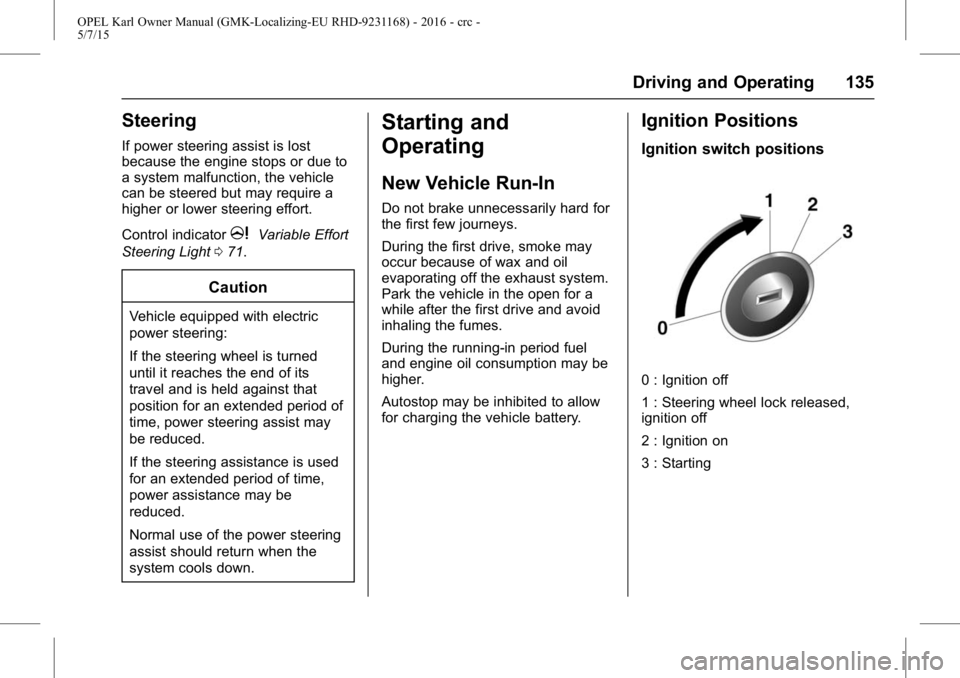
OPEL Karl Owner Manual (GMK-Localizing-EU RHD-9231168) - 2016 - crc -
5/7/15
Driving and Operating 135
Steering
If power steering assist is lost
because the engine stops or due to
a system malfunction, the vehicle
can be steered but may require a
higher or lower steering effort.
Control indicator
mVariable Effort
Steering Light 071.
Caution
Vehicle equipped with electric
power steering:
If the steering wheel is turned
until it reaches the end of its
travel and is held against that
position for an extended period of
time, power steering assist may
be reduced.
If the steering assistance is used
for an extended period of time,
power assistance may be
reduced.
Normal use of the power steering
assist should return when the
system cools down.
Starting and
Operating
New Vehicle Run-In
Do not brake unnecessarily hard for
the first few journeys.
During the first drive, smoke may
occur because of wax and oil
evaporating off the exhaust system.
Park the vehicle in the open for a
while after the first drive and avoid
inhaling the fumes.
During the running-in period fuel
and engine oil consumption may be
higher.
Autostop may be inhibited to allow
for charging the vehicle battery.
Ignition Positions
Ignition switch positions
0 : Ignition off
1 : Steering wheel lock released,
ignition off
2 : Ignition on
3 : Starting
Page 137 of 217
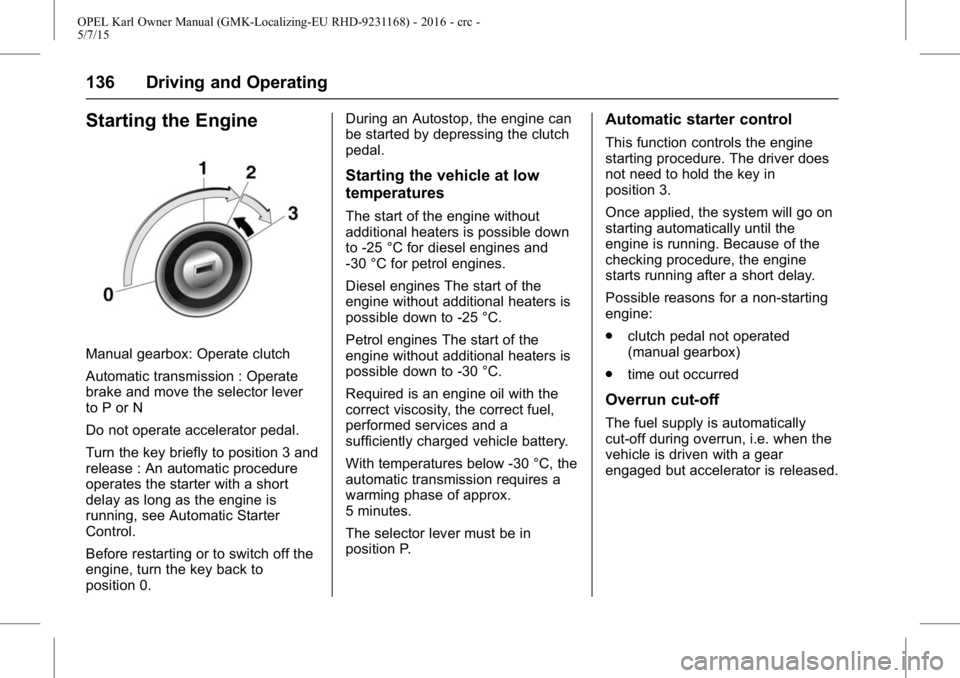
OPEL Karl Owner Manual (GMK-Localizing-EU RHD-9231168) - 2016 - crc -
5/7/15
136 Driving and Operating
Starting the Engine
Manual gearbox: Operate clutch
Automatic transmission : Operate
brake and move the selector lever
to P or N
Do not operate accelerator pedal.
Turn the key briefly to position 3 and
release : An automatic procedure
operates the starter with a short
delay as long as the engine is
running, see Automatic Starter
Control.
Before restarting or to switch off the
engine, turn the key back to
position 0.During an Autostop, the engine can
be started by depressing the clutch
pedal.
Starting the vehicle at low
temperatures
The start of the engine without
additional heaters is possible down
to -25 °C for diesel engines and
-30 °C for petrol engines.
Diesel engines The start of the
engine without additional heaters is
possible down to -25 °C.
Petrol engines The start of the
engine without additional heaters is
possible down to -30 °C.
Required is an engine oil with the
correct viscosity, the correct fuel,
performed services and a
sufficiently charged vehicle battery.
With temperatures below -30 °C, the
automatic transmission requires a
warming phase of approx.
5 minutes.
The selector lever must be in
position P.
Automatic starter control
This function controls the engine
starting procedure. The driver does
not need to hold the key in
position 3.
Once applied, the system will go on
starting automatically until the
engine is running. Because of the
checking procedure, the engine
starts running after a short delay.
Possible reasons for a non-starting
engine:
.
clutch pedal not operated
(manual gearbox)
. time out occurred
Overrun cut-off
The fuel supply is automatically
cut-off during overrun, i.e. when the
vehicle is driven with a gear
engaged but accelerator is released.
Page 138 of 217
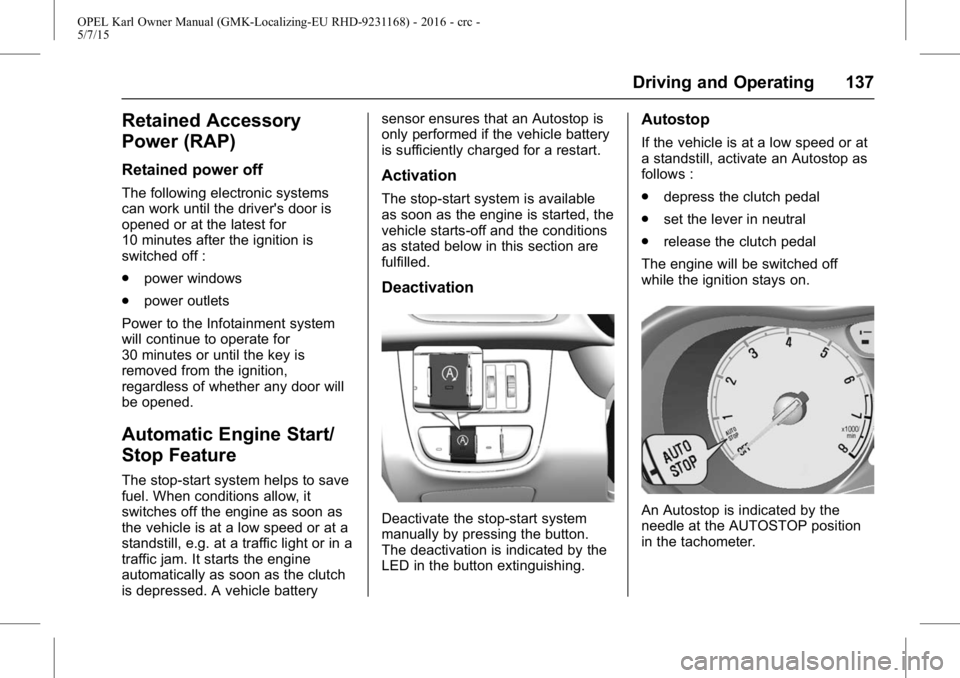
OPEL Karl Owner Manual (GMK-Localizing-EU RHD-9231168) - 2016 - crc -
5/7/15
Driving and Operating 137
Retained Accessory
Power (RAP)
Retained power off
The following electronic systems
can work until the driver's door is
opened or at the latest for
10 minutes after the ignition is
switched off :
.power windows
. power outlets
Power to the Infotainment system
will continue to operate for
30 minutes or until the key is
removed from the ignition,
regardless of whether any door will
be opened.
Automatic Engine Start/
Stop Feature
The stop-start system helps to save
fuel. When conditions allow, it
switches off the engine as soon as
the vehicle is at a low speed or at a
standstill, e.g. at a traffic light or in a
traffic jam. It starts the engine
automatically as soon as the clutch
is depressed. A vehicle battery sensor ensures that an Autostop is
only performed if the vehicle battery
is sufficiently charged for a restart.
Activation
The stop-start system is available
as soon as the engine is started, the
vehicle starts-off and the conditions
as stated below in this section are
fulfilled.
Deactivation
Deactivate the stop-start system
manually by pressing the button.
The deactivation is indicated by the
LED in the button extinguishing.
Autostop
If the vehicle is at a low speed or at
a standstill, activate an Autostop as
follows :
.
depress the clutch pedal
. set the lever in neutral
. release the clutch pedal
The engine will be switched off
while the ignition stays on.
An Autostop is indicated by the
needle at the AUTOSTOP position
in the tachometer.
Page 139 of 217
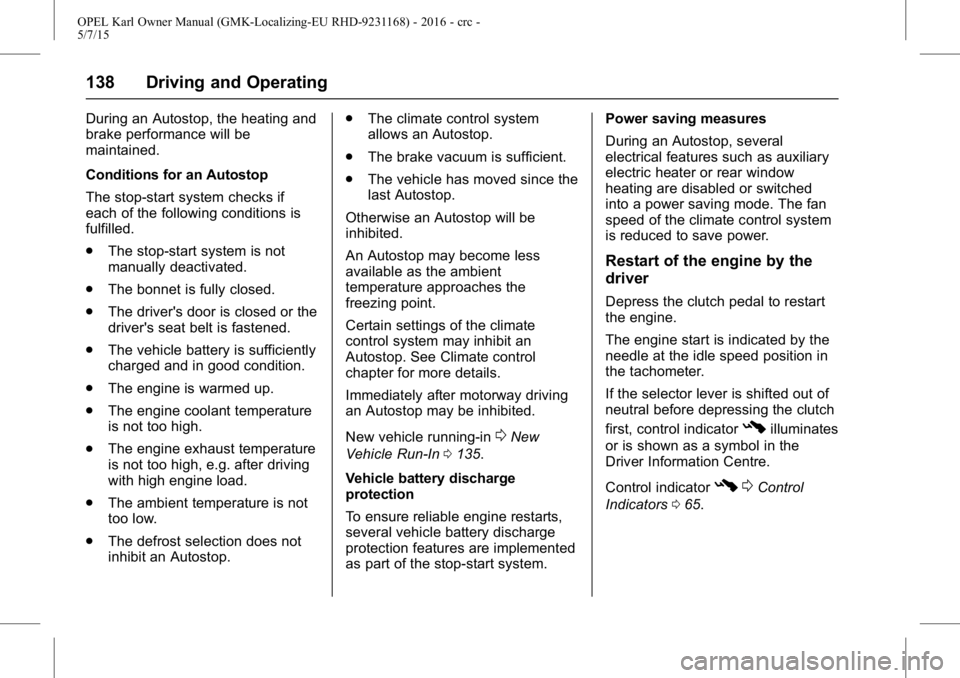
OPEL Karl Owner Manual (GMK-Localizing-EU RHD-9231168) - 2016 - crc -
5/7/15
138 Driving and Operating
During an Autostop, the heating and
brake performance will be
maintained.
Conditions for an Autostop
The stop-start system checks if
each of the following conditions is
fulfilled.
.The stop-start system is not
manually deactivated.
. The bonnet is fully closed.
. The driver's door is closed or the
driver's seat belt is fastened.
. The vehicle battery is sufficiently
charged and in good condition.
. The engine is warmed up.
. The engine coolant temperature
is not too high.
. The engine exhaust temperature
is not too high, e.g. after driving
with high engine load.
. The ambient temperature is not
too low.
. The defrost selection does not
inhibit an Autostop. .
The climate control system
allows an Autostop.
. The brake vacuum is sufficient.
. The vehicle has moved since the
last Autostop.
Otherwise an Autostop will be
inhibited.
An Autostop may become less
available as the ambient
temperature approaches the
freezing point.
Certain settings of the climate
control system may inhibit an
Autostop. See Climate control
chapter for more details.
Immediately after motorway driving
an Autostop may be inhibited.
New vehicle running-in
0New
Vehicle Run-In 0135.
Vehicle battery discharge
protection
To ensure reliable engine restarts,
several vehicle battery discharge
protection features are implemented
as part of the stop-start system. Power saving measures
During an Autostop, several
electrical features such as auxiliary
electric heater or rear window
heating are disabled or switched
into a power saving mode. The fan
speed of the climate control system
is reduced to save power.
Restart of the engine by the
driver
Depress the clutch pedal to restart
the engine.
The engine start is indicated by the
needle at the idle speed position in
the tachometer.
If the selector lever is shifted out of
neutral before depressing the clutch
first, control indicator
#illuminates
or is shown as a symbol in the
Driver Information Centre.
Control indicator
# 0Control
Indicators 065.
Page 140 of 217
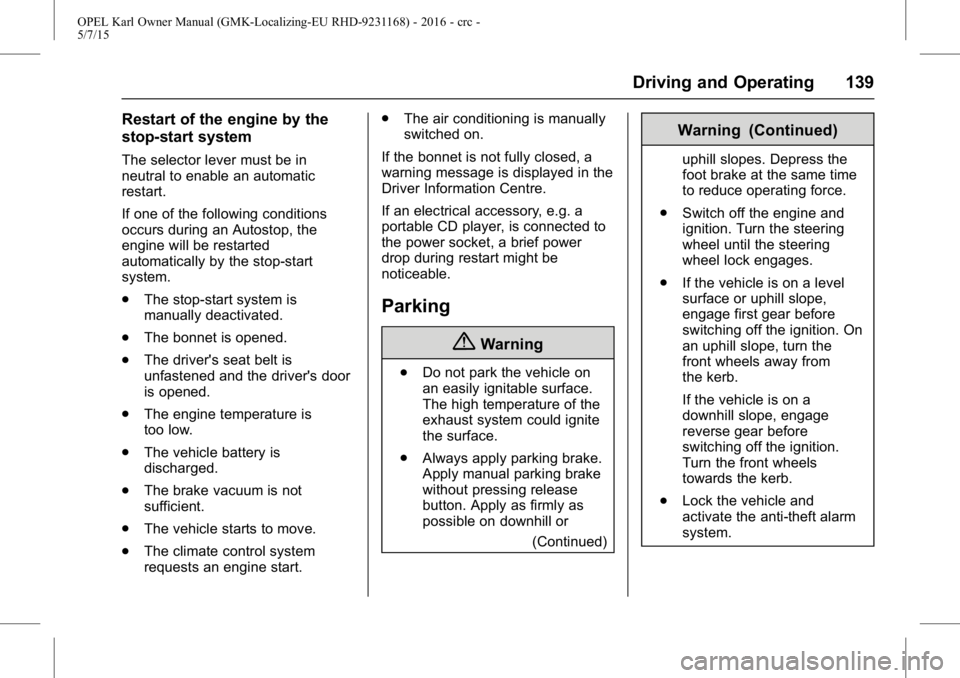
OPEL Karl Owner Manual (GMK-Localizing-EU RHD-9231168) - 2016 - crc -
5/7/15
Driving and Operating 139
Restart of the engine by the
stop-start system
The selector lever must be in
neutral to enable an automatic
restart.
If one of the following conditions
occurs during an Autostop, the
engine will be restarted
automatically by the stop-start
system.
.The stop-start system is
manually deactivated.
. The bonnet is opened.
. The driver's seat belt is
unfastened and the driver's door
is opened.
. The engine temperature is
too low.
. The vehicle battery is
discharged.
. The brake vacuum is not
sufficient.
. The vehicle starts to move.
. The climate control system
requests an engine start. .
The air conditioning is manually
switched on.
If the bonnet is not fully closed, a
warning message is displayed in the
Driver Information Centre.
If an electrical accessory, e.g. a
portable CD player, is connected to
the power socket, a brief power
drop during restart might be
noticeable.
Parking
{Warning
. Do not park the vehicle on
an easily ignitable surface.
The high temperature of the
exhaust system could ignite
the surface.
. Always apply parking brake.
Apply manual parking brake
without pressing release
button. Apply as firmly as
possible on downhill or
(Continued)
Warning (Continued)
uphill slopes. Depress the
foot brake at the same time
to reduce operating force.
. Switch off the engine and
ignition. Turn the steering
wheel until the steering
wheel lock engages.
. If the vehicle is on a level
surface or uphill slope,
engage first gear before
switching off the ignition. On
an uphill slope, turn the
front wheels away from
the kerb.
If the vehicle is on a
downhill slope, engage
reverse gear before
switching off the ignition.
Turn the front wheels
towards the kerb.
. Lock the vehicle and
activate the anti-theft alarm
system.